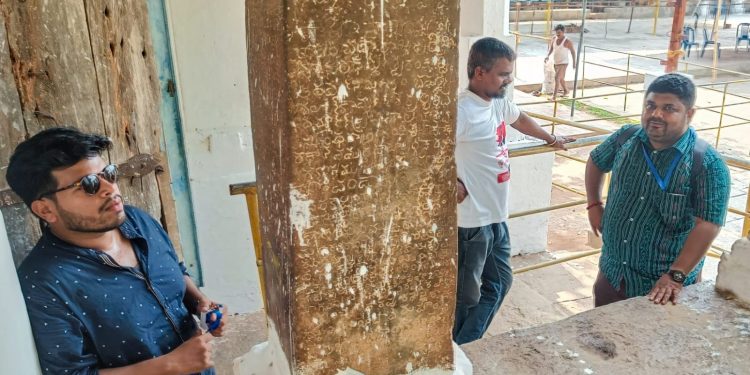Bhubaneswar: A rare 14th-century inscription found at the Dharmalingeswar Temple at Panchadharla in Anakapalli district of Andhra Pradesh has brought to light the hitherto unknown military victory of the combined forces of the Eastern Ganga dynasty of Utkala and Haihaya rulers over the imperial armies of Delhi’s Tughlaq rulers. The discovery is featured in a recently released book, ‘ Relics of Kalinga in South India, Part-I’, published by the Indian National Trust for Art and Cultural Heritage (INTACH), Odisha State Chapter. The inscription, carved on a three-faced black stone pillar at the eastern entrance of the temple, was documented in November 2024 by a three-member INTACH team comprising project coordinator and author Deepak Kumar Nayak, epigraphist Bishnu Mohan Adhikari, and surveyor Suman Prakash Swain.
The inscription- written in Sanskrit language, using Telugu script – dates to Saka Samvat 1325 (1403 CE), during the reign of King Choda III of the Haihaya dynasty. Verse 16 of the 93-line inscription mentions that Choda III constructed a gopura (gateway) and a grove at the temple’s entrance, commemorating the defeat of Firuz Shah Tughlaq of Delhi by Choda II, an earlier Haihaya ruler and subordinate of Eastern Ganga king Bhanudeva III – King of Utkala (modern-day Odisha).
As per epigraphist Adhikari, following the victory, Choda II gifted 22 elephants to Bhanudeva III and presented dancing girls to the Sultan of Pandua as ‘Bijayashri’—tokens of triumph. The inscription further suggests that the Sultan of Pandua may have been a vassal or allied commander under the Eastern Ganga ruler. The Haihayas of Panchadharla ruled the southern Kalinga region, including Simhachalam and Panchadharla, from the 12th to 14th centuries CE. The revelation reaffirms the Eastern Ganga dynasty’s extensive influence and the crucial role played by regional powers like the Haihayas in resisting northern invasions during medieval India.






































